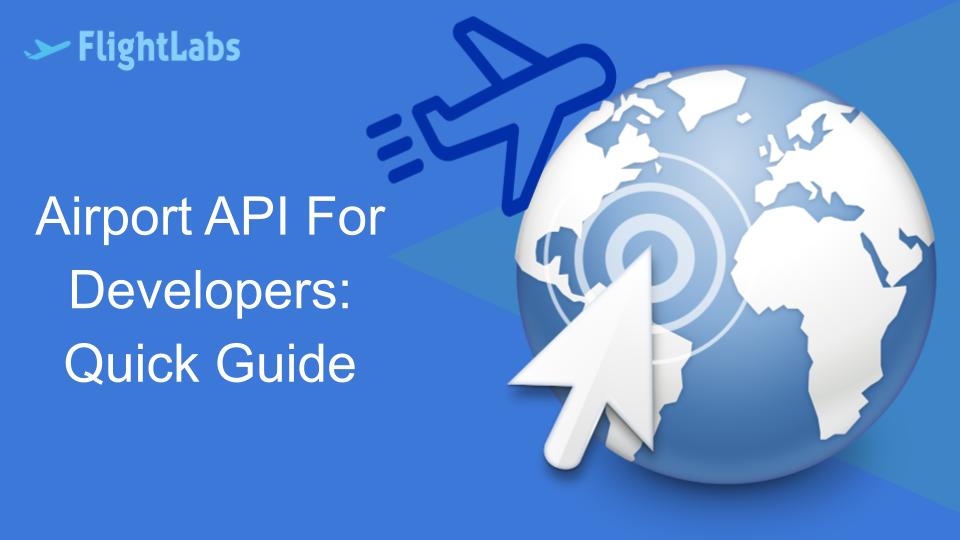Airport API For Developers: Quick Guide

As a developer in the aviation industry, leveraging Airport APIs can significantly enhance your applications and provide valuable insights for users. These APIs offer access to a wide range of aviation data, including flight schedules, airport facilities, weather conditions, and more. In this quick guide, we'll explore the key features of Airport APIs and provide a roadmap for developers to integrate them effectively into their projects.
Understanding Airport APIs:
Airport APIs are application programming interfaces that provide developers with access to data and functionalities related to airports and aviation. These APIs allow developers to retrieve real-time flight information, access airport facilities data, retrieve weather forecasts, and more. Understanding the capabilities and data offered by Airport APIs is crucial for leveraging them effectively in your applications.

Choosing the Right Airport API: FlightLabs
Before integrating FlightLabs into your project, it's essential to choose the right API that meets your requirements. Consider factors such as data coverage, real-time updates, data formats, authentication methods, pricing, and support. Look for APIs that offer comprehensive data coverage, reliable real-time updates, easy-to-use data formats (such as JSON or XML), secure authentication options, competitive pricing, and robust support resources.
Authentication and Access:
Once you've selected FlightLabs, the next step is to set up authentication and access permissions. Most Airport APIs require developers to obtain API keys or tokens for authentication purposes. Follow the API provider's documentation to generate API keys, configure access permissions, and authenticate API requests. Ensure that your authentication process is secure and complies with best practices for API security.
Exploring Data Endpoints:
After authentication, developers can start exploring the data endpoints provided by the FlightLabs. Data endpoints allow developers to retrieve specific sets of data, such as flight schedules, airport facilities, weather conditions, ground transportation options, and more. Familiarize yourself with the available data endpoints, their parameters, and response formats to effectively retrieve and integrate data into your applications.
Integrating Data Into Applications:
Integrating FlightLabs data into your applications involves making API requests, processing responses, and displaying relevant information to users. Use programming languages and frameworks that support API integration, such as Python, JavaScript, PHP, or Ruby on Rails. Utilize API client libraries, SDKs, or HTTP request libraries to streamline API integration and handle data processing efficiently.
Real-Time Updates and Notifications:
One of the key advantages of FlightLabs is access to real-time updates on flight statuses, delays, cancellations, gate assignments, and more. Leverage these real-time updates to provide users with timely information and notifications in your applications. Implement push notifications, email alerts, or in-app notifications to keep users informed about changes and updates related to flights and airports.
User Experience Enhancements:
Enhance the user experience of your applications by leveraging FlightLabs data to provide intuitive interfaces, interactive maps, personalized recommendations, and seamless booking experiences. Use the rich data provided by the API to create engaging visualizations, such as flight trackers, airport maps, weather widgets, and ground transportation options. Tailor the user experience to meet the needs and preferences of your target audience.

Testing and Optimization:
Before deploying your applications with integrated FlightLabs, conduct thorough testing to ensure data accuracy, performance, and reliability. Test different use cases, scenarios, and edge cases to identify and resolve any issues or bugs. Optimize API integration for speed, efficiency, and scalability to handle varying user loads and data volumes. Continuously monitor API performance and user feedback to make iterative improvements and optimizations.
Conclusion:
In conclusion, FlightLabs offers developers a wealth of opportunities to enhance their applications with valuable aviation data and functionalities. By choosing the right API, setting up authentication, exploring data endpoints, integrating data effectively, providing real-time updates, enhancing the user experience, testing thoroughly, and optimizing performance, developers can create innovative and user-friendly applications that cater to the needs of the aviation industry. Embrace Airport APIs as powerful tools to transform your development projects and deliver exceptional experiences to users in the aviation domain.